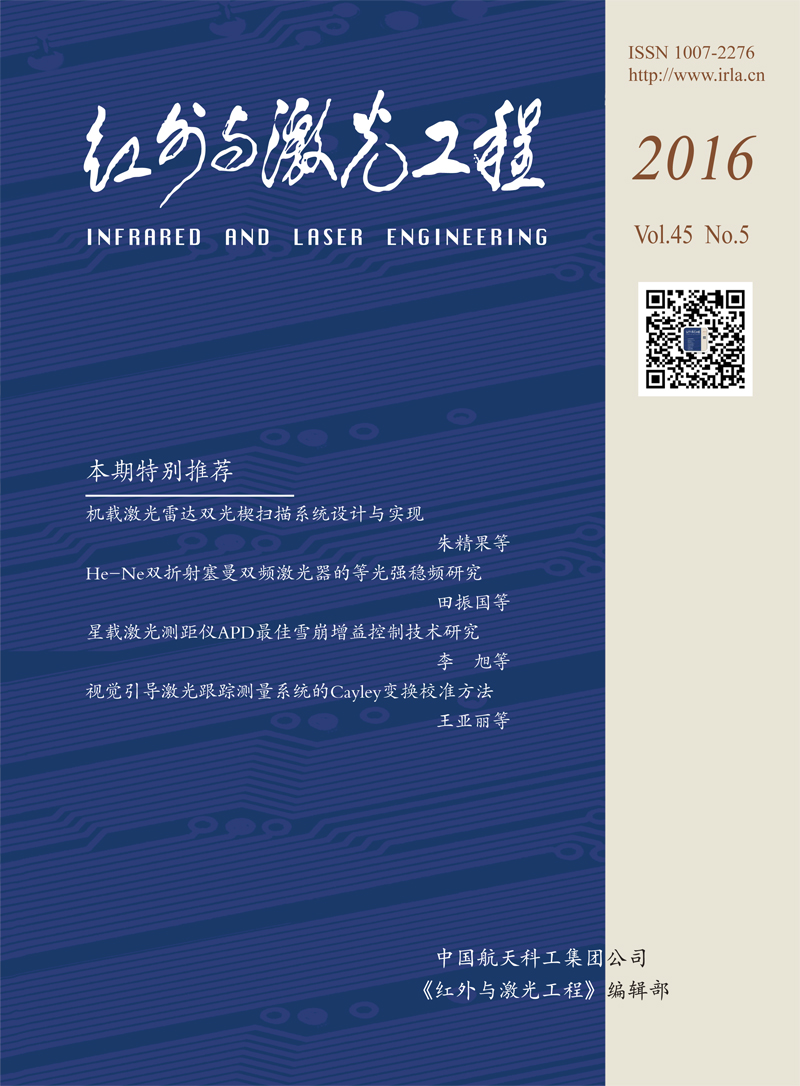|
[1]
|
Gong Junliang, He Xin, Wei Zhonghui, et al. Infrared dim and small target detection method using scale-space theory[J]. Infrared and Laser Engineering, 2013, 42(9): 2566-2573. (in Chinese)龚俊亮, 何昕, 魏仲慧, 等. 采用尺度空间理论的红外弱小目标检测方法[J]. 红外与激光工程, 2013, 42(9): 2566-2573. |
|
[2]
|
Qu Shiru, Yang Honghong. Multi-target detection and tracking of video sequence based on Kalman_BP neural network[J]. Infrared and Laser Engineering, 2013, 42(9): 2553-2560. (in Chinese)曲仕茹, 杨红红. 采用Kalman_BP神经网络的视频序列多目标检测与跟踪[J]. 红外与激光工程, 2013, 42(9): 2553-2560. |
|
[3]
|
Li Yimang, Wei Zhonghui, Guo Jingming. Infrared targets detection and recognition using dimension reduction technology[J]. Optics and Precision Engineering, 2013, 21(5): 1297-1303. (in Chinese)李一芒, 魏仲慧, 郭敬明. 采用降维技术的红外目标检测与识别[J]. 光学精密工程, 2013, 21(5): 1297-1303. |
|
[4]
|
Wang Gang, Yu Bingxi. Approach to estimate infrared point-target detection range against sky background based on contrast[J]. Optics and Precision Engineering, 2002, 10(3): 276-280. (in Chinese)王刚, 禹秉熙. 基于对比度的空中红外点目标探测距离估计方法[J]. 光学精密工程, 2002, 10(3): 276-280. |
|
[5]
|
Lv Yinhuan, Zhang Tao, Tong Guanghui. Design of optical system based on diffraction optics for infrared weak target detection[J]. Chinese Optics, 2009, 2(6): 543-549. (in Chinese)吕银环, 张涛, 童广辉. 基于衍射光学元件的红外弱目标探测系统设计[J]. 中国光学, 2009, 2(6): 543-549. |
|
[6]
|
Li Bo. Application and development trend of infrared stealth technology[J]. Chinese Optics, 2013, 6(6): 818-823. (in Chinese)李波. 红外隐身技术的应用及发展趋势[J]. 中国光学, 2013, 6(6): 818-823. |
|
[7]
|
Reed I S, Gagliardi R M, Shao H M. Application of three-dimensional filtering to moving target detection[J]. IEEE Trans AES, 1983, 19(6): 898-904. |
|
[8]
|
Barniv Y, Kella Offer. Dynamic programming solution for detecting dim moving targets[J]. IEEE Trans AES, 1987, 21(11): 776-788. |
|
[9]
|
Rollason M, Samond D J. A particle filter for track-before-detect of a target with unknown amplitude[C]//IEE Seminar on Target Tracking: Algorithms and Applications, 2001. |
|
[10]
|
Wang Luping, Zhang Luping, Han Jiantao. Detecting algorithm of moving target in dynamic background based on gray-weighted kernel function[J]. Infrared and Laser Engineering, 2013, 42(12): 3453-3457. (in Chinese)王鲁平, 张路平, 韩建涛. 采用灰度加权核函数的动态背景运动目标检测算法[J]. 红外与激光工程, 2013, 42(12): 3453-3457. |
|
[11]
|
Wald A. Sequential Analysis[M]. New York: Wiley, 1947: 50-55. |
|
[12]
|
McConnell I, Oliver C J. A comparison of segmentation methods with standard CFAR for point target detection[C]//SPIE, 1998, 3497: 76-87. |
|
[13]
|
Page E S. A test for a change in a parameter occurring at an unknown point[J]. Biometrika, 1955, 42(3/4): 523-527. |
|
[14]
|
Roberts S W. Control chart tests based on geometric moving average[J]. Technometrics, 2000, 42(1): 97-101. |
|
[15]
|
Emanuele Grossi, Marco Lops. Sequential detection of Markov targets with trajectory estimation[J]. IEEE Trans Inf Theory, 2008, 54(9): 4144-4154. |
|
[16]
|
Chen Li, Han Chongzhao, Zhu Hongyan. Detection performance loss due to jitter in naval IRST systems[J]. IEEE Transactions on Aerospace and Electronic Systems, 2008, 44(1): 326-338. |
|
[17]
|
Tartakovsky A, Blazek R. Effective adaptive spatial-temporal technique for clutter rejection in IRST[C]//SPIE Proceedings: Signal and Data Processing of Small Targets, 2000, 4048: 85/1-11. |
|
[18]
|
Tartakovsky A, Kligys S, Petrov A. Adaptive sequential algorithms for detecting targets in a heavy IR clutter[C]//SPIE Proceedings: Signal and Data Processing of Small Targets, 1999, 3809: 119/1-12. |
|
[19]
|
Alexander G Tartakovsky, Venugopal V Veeravalli. An efficient sequential procedure for detecting changes in multichannel and distributed systems[C]//ISIF, 2002, 1: 41-48. |
|
[20]
|
Alexander G Tartakovsky, Li X R, George Yaralov. Sequential detection of targets in multichannel systems[J]. IEEE Trans Inf Theory, 2003, 49(2): 425-445. |









 DownLoad:
DownLoad: